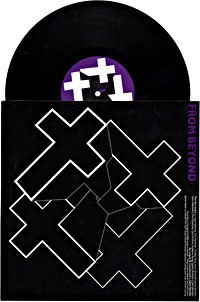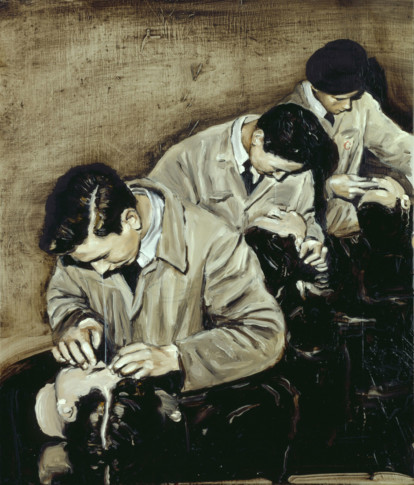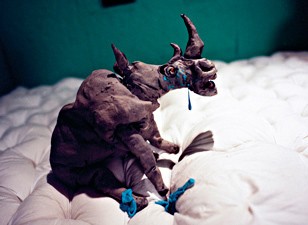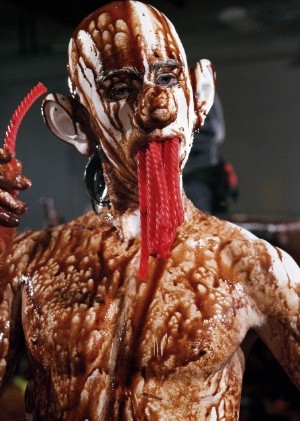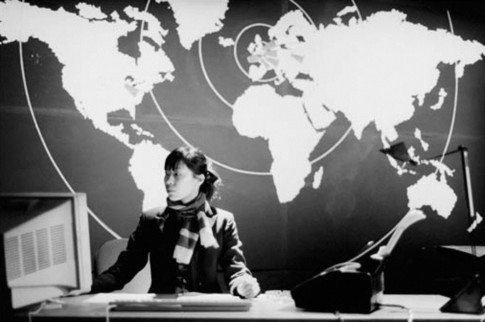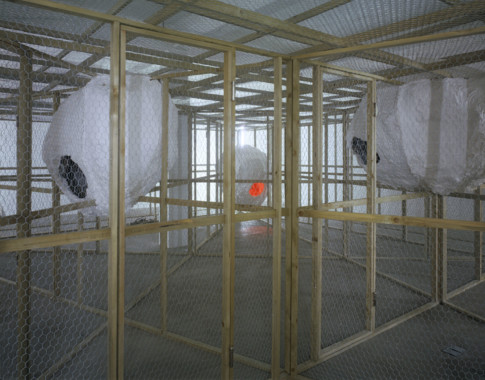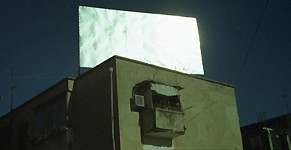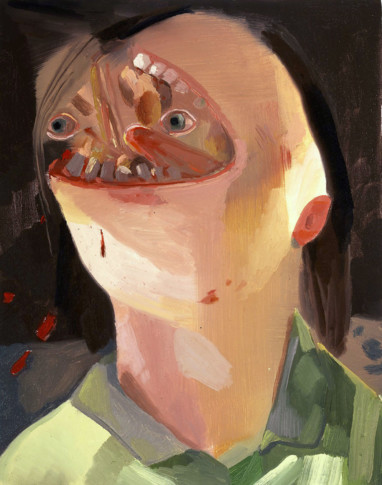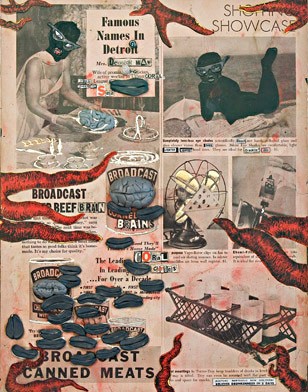
Ellen Gallagher, Coral Cities (Korallstäder), 2007 Private Collection © Mike Bruce
Ellen Gallagher
Based on archive material Ellen Gallagher has mined from American “race” magazines such as Ebony, Our World, and Sepia; DeLuxe is built through a series of transformations using photogravure, photomontage, abrasion, drypoint, tattoo-machine engraving and adding cut paper, toy eyeballs, pomade and plasticine. Within this imaginary theatre with conscripted characters re-enacting historical and mythological roles, DeLuxe presents the capitalist promise of integration as a cruel masquerade.
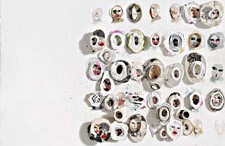
Ellen Gallagher
Dirty O´s, 2006
Courtesy Hauser & Wirth Collection, Switzerland
© Mike Bruce
In Eclipse. Art in a Dark Age, DeLuxe is exhibited together with a selection of drawings from Gallagher’s Watery Ecstatic series. In these works she continues to question how we reflect on memory and history. Playing a critical role in this reconfiguring of memory is the concept of a Black Atlantis. The story is based on the Atlantic slave trade, the route known as the Middle Passage, where the sick and dying abducted passengers were thrown overboard or took their own lives by jumping into the ocean.
With this violent history in mind, a Detroit-based trio of electronic musicians began the project known as Drexciya. The trio developed the myth of an aquatic species that evolved from the drowned slaves. Drexciya declared their soundscapes were created by channelling aural hallucinations made up of messages or echoes from the Middle Passage. In Drexciya, airplanes, trains, cars, and bicycles are replaced by UAOs, or Unknown Audio Objects, imaginary soundcrafts that move through the suboceanic Drexciyan landscape. These UAOs propel themselves using instrumental pulses and sequences and generate an aquatic environment made up of unclassifiable form in motion. As a result of these various and unknowable forms of auto-motion, listeners cannot assume a transparent relationship between musician and composition. Therefore, identification becomes unreliable.
This mysterious and evocative condition is enfolded into the dark matter of Gallagher’s work. Understood in this way, the Middle Passage becomes the true and ultimate form of alien abduction: people are abducted from their homes, kidnapped from their families, transported through unfamiliar waters.* For Ellen Gallagher, the voyage of the Middle Passage, rather than the stasis of plantation ideology or any redemptive fantasy of Mother Africa, functions as an myth of origin to which African Americans can refer. In images representing the depths of the ocean that connects all the continents, this ghostly, fragile and exquisite community lies hidden among seaweed, fish, and other marine life.
When image is added to image in Gallagher’s oeuvre, the metaphor of the forces that are in motion underneath the surface – and not just the surface of the water – grow stronger and stronger. Gallagher herself says that it is about movement, about diving down into an altered state, about the Voyage as a potential and a base for creating something new. Reality is always more than the present, and this excess can be understood as passage to symbolic and thereby social potentiality. FL
*See Ishmael Reed, Greg Tate, and Kodwo Eshun in The Last Angel of History dir. John Akomfrah/ Black Audio Film Collective, 1995.
Fredrik Liew
Ellen Gallagher
Born 1965. Lives and works in Rotterdam and New York.
Education
1992 School of the Museum of Fine Arts, Boston MA [US]
1989 Studio 70, Ft. Tomas, Kentucky [US]
1982–1984 Oberlin, Ohio [US]
Selected solo exhibitions
2007
Coral Cities, Tate Liverpool, Liverpool [GB] Turné till/Travelled to: Hugh Lane Gallery, Dublin [IE]
2005
DeLuxe, Whitney Museum of American Art, New York, NY [US]
2004
Orbus, Fruitmarket Gallery, Edinburgh [GB]
2001
Watery Ecstatic, Boston [US]
Selected group exhibitions
2007–2008
Passages from History, Tate Modern, London [GB]
2007
Comic Abstraction, Museum of Modern Art, New York, NY [US]
2006
Heart of Darkness, Walker Art Center, Minneapolis, MN [US]
2003
La Biennale di Venezia, Venedig/Venice [IT]
Selected bibliography
Ellen Gallagher. Coral Cities (utst.kat./exh. cat.), Tate Liverpool, London: Tate Publishing, 2007
Ellen Gallagher and Edgar Cleijne: MURMUR, The Fruitmarket Gallery, Hauser & Wirth Zürich London, Rotterdam, 2005
Ellen Gallagher (utst.kat./exh. cat.), Jessica Morgan, Robert Storr [et al.] (red./ed.), Boston: ICA/New York: D.A.P., 2001
Ellen Gallagher (utst.kat./exh. cat.), Anthony d’Offay Gallery, London: Anthony d’Offay Gallery, 2001

